(21,07,21)
“Xenochrony” is a musical technique associated with Frank Zappa, who coined the name from the Greek words xeno (strange) and chrono (time). According to Zappa, “In this technique, various tracks from unrelated sources are randomly synchronized with each other to make a final composition with rhythmic relationships unachievable by other means.”
Since the summer of 2020 the barbarism of pure culture has linked to archived weekly radio broadcasts from the Late Lunch with Out to Lunch show on Resonance 104.4 FM.
As in 2021 and the Covid Crisis and our favourite xenochronic musians are still alive and kicking, we are relaunching our support with the following links:
Ben Watson takes the Late Lunch House Band, honed via several years playing weekly at the Resonance studio and “xenochronically” during pandemic lockdown, to the Betsey Trotwood pub on Farringdon Road for a live session. The Lessons of Xenochrony are not forgotten, though, so you also get to hear the superb post-Bailey guitar of James Wilson of Music With My Insane Friend (“The Castro Eulogies (My Friend Fidel)” and “No Imagination (My Plastic Bottle Caught in the Strings)” from I Digress Indeed’s Retirement Music (SoundCloud, 2017) and “Leguminous Legroom Trio” a xenochronic composition combining Peter Baxter “Pots, Pans & an Open Window” 14-vii-2021 8:13, Out To Lunch’s organ piece “Nachsteuererklaerungsjubel” and Robert “Sugarlips” Goldsmith’s “On Cloud Roland Nine”). Association of Musical Marxists All-Stars at the Betsey Trotwood 16-vii-2021: Peter Baxter – pots’n’pans and electronics; Guy Evans – percussion; Iris Watson – djembe hand drum, thunder tube, handclaps; Luke Davis – typewriter, poetry; Out To Lunch – vocals, thunder tube, handclaps, word jazz, yamaha organ, mix, xenochronics; Dave Black – electric guitar; Robert “Sugarlips” Goldsmith – sopranino sax, tenor sax, baritone sax.
Xenochronic AMM All-Stars in order of appearance (not counting excerpts in the theme tune opener): Graham Davis – synth, electric guitars; Robert “Sugarlips” Goldsmith – saxophone; Out To Lunch – Splash’n’Klang, tap drip, recitation, xenochrony; Mike Watt – electric bass; Ben Moran Healy – acoustic guitar, electric guitar, recitation; Eleanor Crook – electric guitar, wah bass; Mike Watt – electric bass; Guy Evans – hybrid drumset.
0:00 Marc Guillermont’s “Make a Blues Noise Here” plus two excerpts from RSG’s “Response to Foistive Thirty Take One”; GE “Little of the Original Structure Remains” 0:29>>0:34; GD “Fat Bassist Ponders Life” 1:41>>1:56, 0:00>>0:22; GE “Posthorn Pat” 0:23>>0:53; OTL/BMH “Pesky Attic Dooda” 7:49>>8:16; OTL “Water3” 9-x-2018 4:06>>4:34 + EC/GD “Twixt the Shed & Here #3” 1:30>>1:59 4:30
4:59 Toilets or Marx – Don’t Make Me Choose (GD/RSG “Foistive Thirty Take One” 7:20>>10:15/OTL “Water3” 9-x-2018 13:26>>14:13/MW “Foist #12” 1:03 spaced) 3:13
8:46 Foistive Thirty feat. Robert “Sugarlips” Goldsmith on tenor sax (RSG/OTL “Tap Drip 12-iv-2021a” 8:47>>44:48/BMH “Biblical Rain” 4:17, “New Shapes Found in Hovel” 5:17/EC “Response to Iris & Finnegans Wake in London Zoo” 7-v-2022 10:48>>32:57/MW “Foists #112-118″/GE “Response to Here’s That Rainy Day” 2:25, “Response Chain (GE to EC) to PB’s One Splatter” 12:57>>32:03, “Response to EC’s Response to Beefheart Lecture 6&7” 0:27>>3:43/OTL “Splash’n’Klang” 10-vii-2018 1:51>>5:29) 35:51
45:35 Pesky Attic Dooda (BMH “Humped Dooda” (guitar), “June Attic Mildew” (voice)/OTL “Pesky Interim Fly” 23-v-2021/excerpts from “Splash’n’Klang” 4-xii-2018) 9:29
55:35 Shittin’ in a Bag … Again (BMH/OTL “Splash’n’Klang” 10-vii-2018b 1:51>>5:24) 4:38
by
Xenochronic AMM All-Stars
Music assembled from contributions by AMM All-Stars during Covid-19 lockdown. Tracks 1-4 were extracted from Concerto for Graham, an hour (Late Lunch with Out To Lunch broadcast from Resonance 104.4FM 2-3pm 31-iii-2021) in which multi-instrumentalist Graham Davis (guitar, bass ukelele, vocals) responded to a collage put together by OTL. Tracks 6-7 were broadcast on The OTL Show (Soho Radio 8-9am 2-iv-2021): “Blob Stance” is an acoustic guitar improvisation by Ben Moran-Healy with responses from the Somers Town dawn chorus and OTL on piano and penny whistle; “I’m Bleeding Obedience” is a song by Peter Baxter with bass, Chapman stick and synth added by Jair-Rohm Parker Wells. “Clangs the Dearth in my Loins” (track 5), OTL performing Peter Baxter’s online review of Concert for Graham at the piano, is inedit jusq’ici.
All tracks by Xenochronic AMM All-Stars; in order of appearance: Graham Davis – electric guitar, bass ukelele; Out To Lunch – field recording of fireworks at Moss Hall School and dawn chorus in Somers Town, Splash’n’Klang, mouthnoise, piano, penny whistle, organ, xenochrony; Guy Evans – drums; John Roy – banjo; Ben Moran-Healy – guitar; Jair-Rohm Parker Wells – bass guitar, Chapman stick, synths; Mike Watt – bass guitar; Peter Baxter – vocals, drum machine, synth.
- GD/OTL/GE (sped-up)
- GD/OTL
- GD/JR
- OTL (“Tap Drip is Getting Faster” 29-iii-2021; “Organ Response to Mike Watt & Dave Black on 85th Street”)/BMH (“A Nimble Mop Is …”)/GE (“Sunday Piano Just Hybrid Kit 2:36>>7:20)
- PH (words)/OTL/JRPW/MW
- BMH/OTL
- PH/JRPW
Return of the Toby Jug 10-iii-2021
“Make a Blues Noise Here” from Marc Guillermont’s Zappostrophe) intercut with excerpts from: AMM All-Stars “Send Out Assent Dung”; Jair-Rohm Parker Wells “llcontrib060321a”; Dave Black “Blackheart Mountain”; Out To Lunch “Intimation” 11-vii-2020; Guy Evans “Sunrise Piano Response Hybrid Kit Response, Just Kit”; Eleanor Crook “Tiny Surf Hands Just Guitar (Clean Settings)”.
Compost Fetishisation 24-ii-2021
Topics audio esemplasm
LLWOTL 10 February 2010 <CLICK HERE
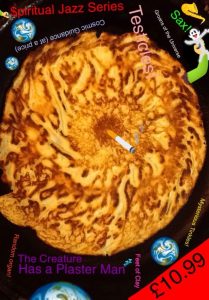 Xenochronic AMM All-Stars in order of appearance: Cloughie – electric bass; Mike Watt – electric bass; Out To Lunch – vocals, empty Turkish Delight box,Yamaha organ, Splash’n’Klang, djembe hand drum, xenochrony, announcements, master plan; Graham Davis – synth; Paul Shearsmith – trumpet; Eleanor Crook – violin, electric guitar; Guy Evans – hybrid drumset, wind capture; Robert “Sugarlips” Goldsmith – baritone sax, telephony; Peter Baxter – electronic devices; Ben Moran-Healy – acoustic guitar, semi-electric guitar.
Xenochronic AMM All-Stars in order of appearance: Cloughie – electric bass; Mike Watt – electric bass; Out To Lunch – vocals, empty Turkish Delight box,Yamaha organ, Splash’n’Klang, djembe hand drum, xenochrony, announcements, master plan; Graham Davis – synth; Paul Shearsmith – trumpet; Eleanor Crook – violin, electric guitar; Guy Evans – hybrid drumset, wind capture; Robert “Sugarlips” Goldsmith – baritone sax, telephony; Peter Baxter – electronic devices; Ben Moran-Healy – acoustic guitar, semi-electric guitar.
LLWOTL 3 February 2021 <CLICK HERE

Polemic, politics, mouth jazz and spontaneous music with Ben Watson. Today: Out To Lunch and his crew address the current craze for sea shanties as Dave Black sings his version of the sea shanty “Haul Away Joe”, and sea water drips through strangely-possessed xenochronic realisations. With OTL on piano, djembe hand drum and xenochronics; Eleanor Crook on electric guitar and wah bass; Graham Davis on synth; Guy Evans at the drumset; Gareth Sager on various instruments.
Tagged
#resonance fm #arts radio #london #late lunch with out to lunch #sea shanties
EARLIER SHOWS
Margulis Forever 23-ix-2020
LISTEN HERE:The OTL Show 11-ix-2020
Episode of Ben Watson‘s Late Lunch with Out To Lunch dedicated to Lynn Margulis, the rebel biologist who lionised evolution via symbiosis and the lateral transfer of genes between species. Xenochronic AMM All-Stars in order of appearance: Jair-Rohm Parker Wells – Chapman Stick, electric bass, processing; Out To Lunch – voice, piano, Splash’n’Klang, poetry; Rob “Sugarlips” Goldsmith – sopranino and tenor saxophones; Graham Davis – synth; Eleanor Crook – violin, electric guitar; Guy Evans – drumset; Cloughie – electric bass; Dave Black – electric guitar; John Roy – synth. All played this week unless otherwise stated.
The OTL Show is an hour of Internet DJing by Ben Watson on Soho Radio. This was a prerecord because the studio was closed due to coronoavirus lockdown, and was broadcast at 8am on Friday 11-ix-2020.
LISTEN HERE: Groove vs. Squeeze 26-viii-2020
Xenochronic AMM All-Stars in order of appearance: Peter Baxter – tabletop percussion; Out To Lunch – announcements, field recording, Splash’n’Klang, Google Gargle, piano, Korg ribbon synth, xenochrony; Ben Moran Healy – electric guitar; Guy Evans – drumset; Rob “Sugarlips” Goldsmith – tenor saxophone; Cloughie – electric bass; Graham Davis – Ladybird recitation, “WPLJ”; Eleanor Crook – electric guitar; Dave Black – acoustic guitar, vocals, harmonica, “Back Back Train” and “Jitterbug Swing”; Charlotte Whelan – tape deck fanny pack; John Roy – banjo.
Title Credit: Bob Cobbing, Lawrence Upton and Christopher Nolan
Image: “Painstaking Accretion” Out To Lunch, Doodle Buddy on Eleanor Crook photograph of oak fungus 29-viii-2020
LISTEN HERE:
By Xenochronic AMM All-Stars
Xenochronic AMM All-Stars in order of appearance: Cloughie – electric bass; Guy Evans – drumset, trumpet; Eleanor Crook – electric guitar; Graham Davis – jingles, synth; Out To Lunch – piano, readings from J. H. Prynne’s Squeezed White Noise, Splash’n’Klang, google gargle, announcements, xenochrony; Jessica Harper – rhythm mashes; Dave Black – bottleneck guitar; Peter Baxter aka The Baxterium “With Beyonce in the Bayou”, acid synth, percussion.
Drip Hop UK 12-viii-2020
Xenochronic AMM All-Stars in order of appearance: Peter Baxter aka The Baxterium – tabletop percussion, sound montage, “Does Anyone Have an Onion?”, “How To Escape a Place with Scree Walls”; Graham Davis – synth, “Mwaaaah”, “Scree”, “Tinkle”; “Sweep”; Out To Lunch – Splash’n’Klang, piano, announcements, xenochrony; Jair-Rohm Parker Wells – double bass; Eleanor Crook – electric guitar; Ben Moran Healy – electric guitar, Melodica, spoon’n’cup; Rob Jones – synth; Rob Goldsmith – sopranino saxophone; Guy Evans – drumset; John Roy – semi-electric guitar.
Groovy Fidget Muffin Rule 5-viii-2020
Xenochronic AMM All-Stars in order of appearance: Out To Lunch – piano, rural mouthnoise, Korg ribbon synth, acoustic guitar, xenochrony, urbane announcements; Ben Moran Healy – electric guitar, acoustic guitar, snuffles; Rob Jones – synth, Melodica, spoon’n’cup; Jessica Harper – harp; Graham Davis – jingles, synth; Paul Hession – drumset; Eleanor Crook – electric guitar, electric bass, pedal steel; Cloughie – electric bass; Dave Black – acoustic guitar, harmonica; Jair-Rohm Parker Wells – double bass; Guy Evans – samples, drumset; John Roy – baby hand drum, synth; Roy Castle – postponed.

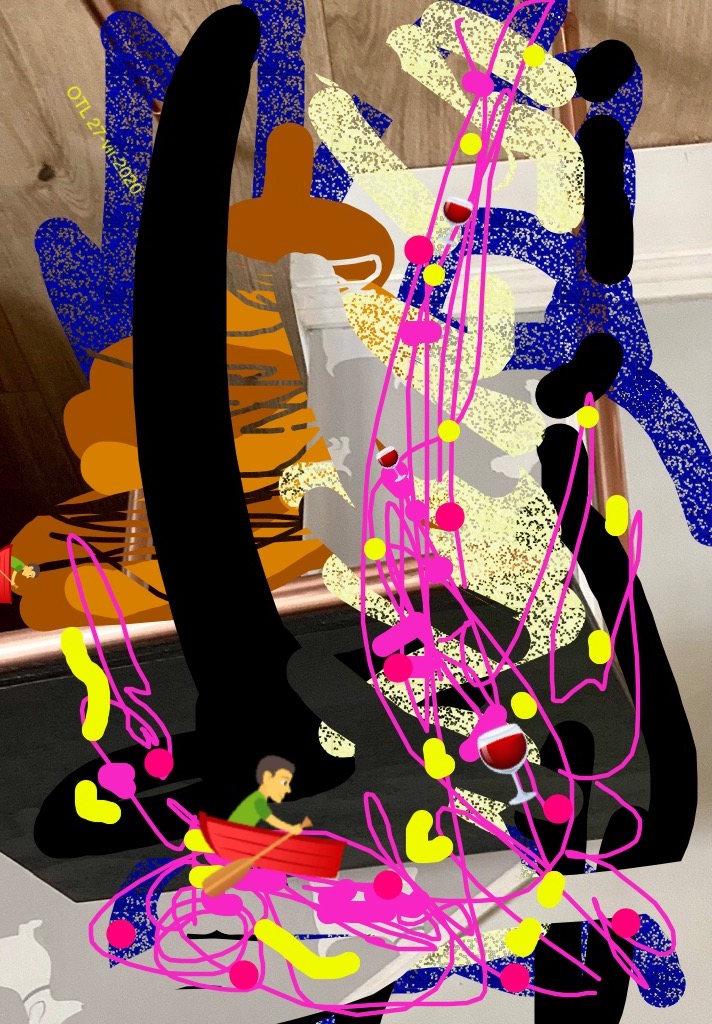
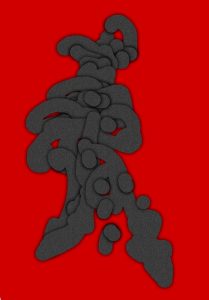
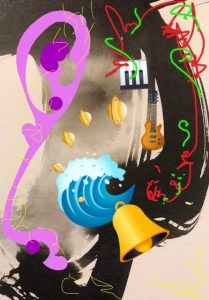
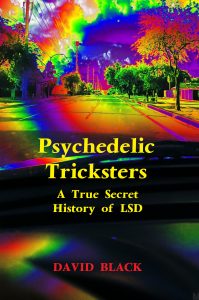
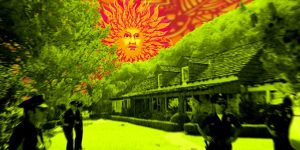
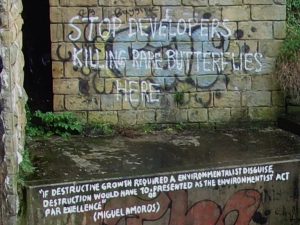
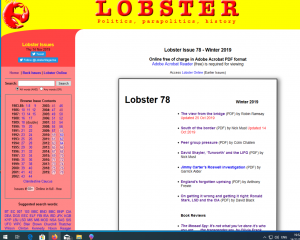
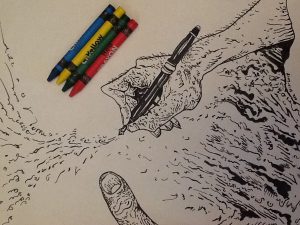 Iain Sinclair reads extracts from his poem Fifty Catacomb Saints accompanied by Peter Baxter – percussion; Robert Goldsmith – baritone sax; Paul Shearsmith – trumpet, pipes, squeakers, Jew’s harp; Dave Black – electric guitar; Graham Davis – synths; Luke Davis – typewriter; and Out To Lunch – splash’n’klang, piano, mouthnoiseThis session was broadcast live on Resonance FM 104.4, July 12th 2018.
Iain Sinclair reads extracts from his poem Fifty Catacomb Saints accompanied by Peter Baxter – percussion; Robert Goldsmith – baritone sax; Paul Shearsmith – trumpet, pipes, squeakers, Jew’s harp; Dave Black – electric guitar; Graham Davis – synths; Luke Davis – typewriter; and Out To Lunch – splash’n’klang, piano, mouthnoiseThis session was broadcast live on Resonance FM 104.4, July 12th 2018.